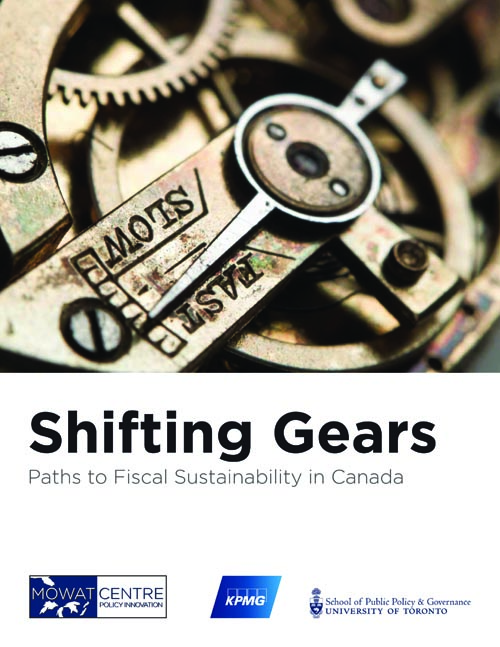December 9, 2010
Paths to Fiscal Sustainability in Canada
This report from the School of Public Policy & Governance and the Mowat Centre at the University of Toronto, supported by KPMG, is a first attempt to identify how well Canadian governments are doing in returning to fiscal balance, when compared to other OECD jurisdictions. It is intended to help facilitate informed, strategic, and long-term decision-making. The top-line recommendation emerging from this study is that the financial crisis and the return of deficit spending provide all governments with an opportunity to examine their budget decisions through a transformative lens.
Executive Summary
Governments around the world face large budget deficits, some of which are structural. Addressing them will require significant fiscal and operational changes within governments.
Some countries are undertaking radical cuts to spending to return to a path of fiscal sustainability. These efforts are reducing the footprint of government and altering some of the basic social benefits that citizens have been receiving from their governments for decades.
Although Canadian governments are in the midst of stimulus spending and are posting high deficits, they do not face a short-term fiscal crisis on par with some European and US state governments.
However, the impending demographic challenges and the structural nature of deficits in most provinces will require Canadian governments to ensure that they can continue to meet public expectations with respect to programming and services while keeping these affordable.
The need to define fiscal sustainability strategies for the long-term provides Canadian governments with an opportunity to examine the choices they face through a “transformative lens,” choosing short-term investments that are likely to re-shape the way government works to ensure fiscal sustainability over the long-term.
Continue reading
Government actions to achieve fiscal sustainability fall into three broad categories. First, governments can increase revenue through higher taxation or user fees.
Second, governments can cut program spending, either through targeted initiatives or across-the-board restraint. Most OECD governments have embarked down the path of program cuts.
Third, governments can change how they operate and how they deliver public services. Efforts under this third umbrella include modernizing government operations through new governance relationships and new financing mechanisms, and by introducing breakthrough technologies and allowing individual citizens more control over how they access public services, with less intermediation by government institutions.
This report recommends that governments devote most of their energy to those strategies that have the greatest likelihood of contributing to long-term fiscal sustainability. Those with the greatest potential will be those where there are few institutional or administrative obstacles to change, where success can produce long-term transformation in how government works or the footprint of government, and where the fiscal pay-off is the largest. Political will and public acceptance will also be crucial.
Particularly promising initiatives include:
- Transformative tax initiatives, such as harmonizing sales tax.
- Transformative policy changes, such as raising the retirement age or requiring more years of service before public sector pensions can be collected.
- Expanding current program reviews and undertaking “whole of system” reviews that include other levels of government and that harmonise functions across governments.
- Applying a more rigorous fiscal lens to ordinary policy decisions that in the past were not thought of as fiscal items.
- Embracing the digitisation revolution which promises to radically transform how individuals access public services.
- Modernizing bureaucratic processes through consolidation and delegating to others those functions which are not government’s core business of policy making, regulation and ensuring compliance.
- Adopting more service delivery models that rely less on direct delivery and more on new networks of government agencies, non-profit organizations, the private sector and individual citizens; improving governance, accountability and measurement of results in these areas will be crucial.
Efforts must also include an intense focus on sectors where expenditures are large, growing rapidly and often include significant transfers to broader public sector institutions. In Canadian provinces, bringing down the rate of escalation in health budgets will be essential or it will be necessary to identify alternative funding methods, such as social insurance, to pay for them. Even within the context of Canada’s public health care model, efficiencies can be gained through changes to the incentive structures in the system, the delivery model and the use of information technologies (IT).
Efforts to ensure that Canadian governments are on a fiscally sustainable path will require from governments acknowledgement of the challenge; credible plans supported by research and fiscal analysis; sustained public communications and dialogue; experimentation, pilot projects and measurement; and the patience and follow-through to enable success, build momentum and facilitate transitions.
The path to sustainability is a societal project that necessitates dialogue across the political spectrum. This project is not an ideological attack on the state. It is about modernizing government so that it can perform its functions better and more efficiently.
The School of Public Policy & Governance and the Mowat Centre will follow progress and report back on the steps governments are taking to return to sustainability in order to facilitate policy learning and identify the most successful strategies.
Author
Matthew Mendelsohn
Release Date
December 9, 2010
ISBN
978-0-9867464-3-7
Mowat Publication
No. 16








